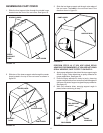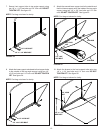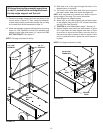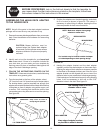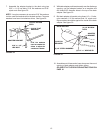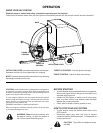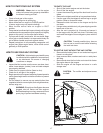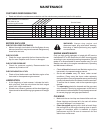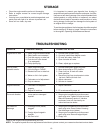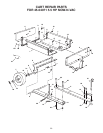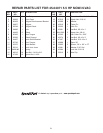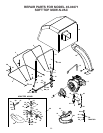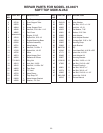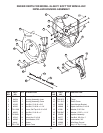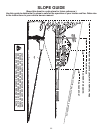
19
PROBLEM POSSIBLE CAUSE(S) CORRECTIVE ACTION
Engine fails to start 1. Spark plug wire disconnected. 1. Connect wire to spark plug.
2. Safety switch not contacted. 2. Correctly install hose adapter nozzle.
3. Fuel tank empty, or stale fuel. 3. Fill tank with clean, fresh fuel.
4. Fuel shut-off valve closed 4. Open fuel shut-off valve.
(if so equipped).
5. Faulty spark plug. 5. Clean, adjust gap or replace.
Loss of power; 1. Spark plug wire loose 1. Connect and tighten spark plug wire.
operation erratic. 2. Unit running on CHOKE. 2. Move choke lever to OFF position.
3. Blocked fuel line or stale fuel. 3. Clean fuel line; ll tank with clean
fresh gasoline.
4. Water or dirt in fuel system. 4. Disconnect fuel line at carburetor to drain
fuel tank. Rell with fresh fuel.
5. Carburetor out of adjustment. 5. Adjust carburetor.*
6. Dirty air cleaner. 6. Service air cleaner.*
Engine overheats 1. Carburetor not adjusted 1. Adjust carburetor.*
properly.
2. Engine oil level low. 2. Fill crankcase with proper oil.
Too much vibration Loose parts or damaged 1. Stop engine immediately and disconnect
impeller. spark plug wire. Tighten all bolts and nuts.
Make all necessary repairs. If vibration
continues, have unit serviced by an
authorized service dealer.
Unit does not 1. Discharge chute (elbow) 1. Stop engine immediately and disconnect
discharge clogged. spark plug wire. Clean inside of housing
and discharge chute (elbow).
2. Foreign object lodged in 2. Stop engine immediately and disconnect
impeller. spark plug wire. Remove lodged object.
3. Vac Cart is full. 3. Empty cart.
*Refer to the engine manual packed with your unit.
NOTE: For repairs beyond the minor adjustments listed above, please contact your nearest authorized service dealer.
• Clean the engine and the entire unit thoroughly.
• Refer to engine manual for correct engine storage
instructions.
• If storing in an unventilated or metal storage shed, coat
metal parts with light oil or silicone to prevent rust.
• Store unit in a clean, dry area.
It is important to prevent gum deposits from forming in
essential fuel system parts such as the carburetor, fuel lter,
fuel hose or tank during storage. Also, alcohol blended fuels
(called gasohol or using ethanol or methanol) can attract
moisture which leads to separation and formation of acids
during storage. Acidic gas can damage the fuel system of
an engine while in storage.
To avoid engine problems, the fuel system should be emptied
before storage of 30 days or longer. Follow the instructions
in the engine’s Operating & Maintenance Manual.
TROUBLESHOOTING
STORAGE



